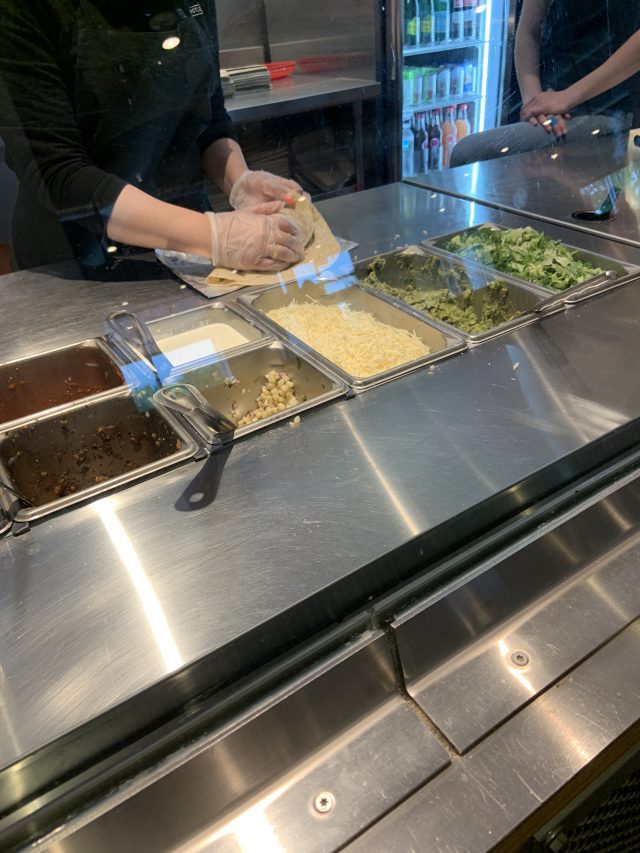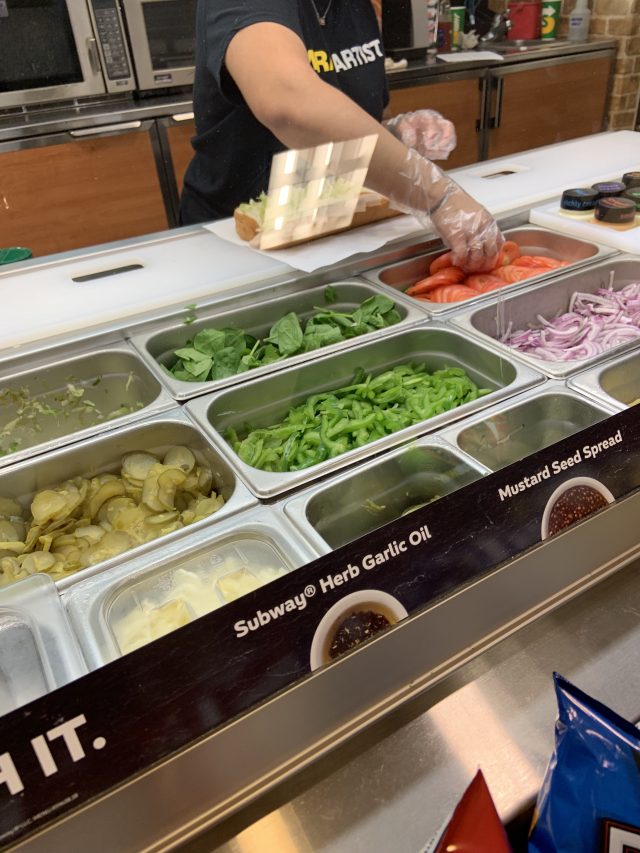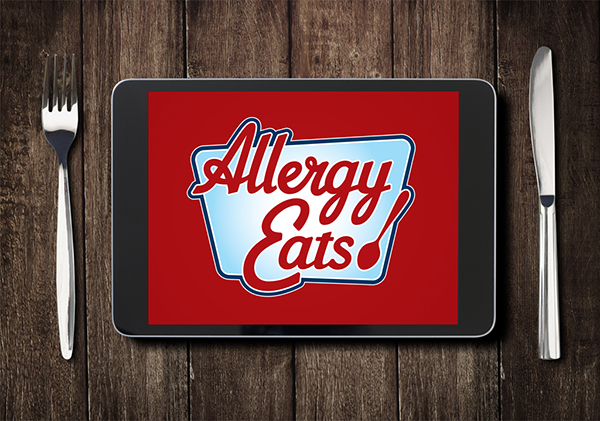Why Can’t Subway Be Like Chipotle With Food Allergies?
This question has vexed me for years. Despite being two different types of restaurants – Chipotle, a fast-casual Mexican restaurant, and Subway, a quick-service sub shop – the setup of each is similar with what I refer to as an assembly line process of creating a guest’s meal. In just looking at their food preparation line and frequenting each restaurant often, one would think that they’d have similar abilities to accommodate food-allergic guests. However, they don’t. Chipotle is a perennial inhabitant of a spot on AllergyEats’ Top 10 Most Allergy-Friendly Restaurant Chains in America list with an overall AllergyEats allergy-friendliness rating of 4.28. On the other hand, Subway has a dismal AllergyEats rating of 3.08 of 5 (US only). So, I decided to call a handful of Subway AND Chipotle restaurants in markets across the US and ask the simplest of questions for comparison.
Both Use An Assembly Line
Both Chipotle and Subway start building a guest’s meal on one end of their food prep line with the “container,” as I’ll call it (sandwich bread, tortilla, bowl, etc.). They each place it on foil (Chipotle) or paper (Subway). They each then slide this “container” down a counter of food, adding products the guest wants as they go. The main proteins and other key ingredients are assembled in the first half, with “toppings” added in the second. (e.g. For a burrito, I might put chicken, black beans, and brown rice on in the first half, with salsa, cheese, and sour cream added in the second. Or for a sub, ham and cheese at the beginning, with lettuce, onions, and pickles at the end.) The final product is then wrapped and ready to go.

A burrito being made on the Chipotle assembly line.
So you see, the restaurants are seemingly very much alike. Now, let me point out a few differences. Subway has a toaster that they use in the middle of the prep for some subs. Chipotle’s food is generally “scooped” from containers, whereas Subway’s sandwiches are assembled by hand (the meats separated by paper for proper proportions). For liquid or semi-liquid toppings, like vinegar or mayo, Subway has squirt bottles, where Chipotle uses a ladle to again scoop queso sauce, hot salsa, and other liquids.

A Subway sandwich being made on the assembly line.
Of the major allergens, Chipotle is probably most challenged by dairy and wheat. Subway is also challenged by these, though they also have to consider soy (in several items), and occasional egg, fish, shellfish, and even tree nuts & peanuts (in cookies). That said, given the assembly line style of preparation and the standardized food products delivered to their store (such that they have an allergen chart applicable to the whole country), I still believe that Subway should be able to accommodate the food allergy community as well, or close to as well, as Chipotle.
Cross-Contact Comparisons
In my opinion, Subway should also have a lesser chance of cross-contact by far. Their food is much less likely to spill and they don’t ladle liquids, choosing instead for a controlled squeeze bottle. The toaster is a risk, but even that can be easily accommodated. The biggest risk should be the potential for cross-contact in the “toppings” area given the use of hands to pick up the food, though even that should have an easy work-around. On the flip side, Chipotle has food that can fall all over the place and liquids that can easily be spilled as they’re ladled across the counter to your food.
So, in the final comparison, I would say Subway and Chipotle each have an easy-to-manage assembly line food preparation area, Subway has a slightly greater challenge of managing more allergens, and Chipotle has a greater cross-contact risk. Advantage? I’d say Subway.
So why does Subway only have a dreadful 3.08 AllergyEats allergy-friendliness rating versus Chipotle’s amazing 4.28? Even other fast food chains are a half point higher than Subway!
As always, it comes down to commitment from management. In this case, I would also add the issue of Subway being a franchised chain as opposed to Chipotle, where the company owns all its restaurants.
Consistency is Key When It Comes to Food Allergy Dining
I am a regular at Subway because my son, despite having tree nut, dairy, and sesame allergies, loves eating there (and we’ve learned how to navigate them). He actually feels safe at Subway because he can see them prepping his food and he can tell them what to do if they’re about to inadvertently make a mistake (which happens way too often). Due to my experiences there, I can tell you that the employees are simply not trained in any responsible way by management, if at all.
I am also a regular at Chipotle and, as most of you have experienced, they clearly have set procedures and protocols in place that are followed to a T most of the time.
Beginning with Subway, every experience I have there is a new adventure. Most of their restaurants don’t have a copy of the ingredient list on the premises, and most don’t even know there’s one online. (That list is important and extremely helpful. Pull it up on your phone if you visit Subway.) Employee reactions when I tell them we have a food allergy? Most often I get a look of “uh, so, why are you telling me that?,” but in fairness there are some who know the next step if nothing else – changing gloves. For those employees who don’t, I ask and they usually do so without questioning – though I have had some who balked at first. And so on down the line. Unfortunately, I don’t think they have a procedure in place to get fresh “toppings” (lettuce, onion, pickles, tomato, etc.) from the back to eliminate cross-contact risk. Why? That should be easy!
At Chipotle, I disclose an allergy and the machine is in motion. Gloves are changed (hands sometimes washed in the middle), allergy is announced, request is made if the customer wants food taken from the back (to prevent their biggest risk – cross-contact – mentioned earlier), and often the same person handles the meal down the whole food prep line to prevent any other cross-contact risk.
I emailed Subway and asked if I could speak to someone about food allergy procedures and for information beyond the allergen chart they have online. They forwarded me the link to the Nutrition & Allergy info on their website. Very nice. I emailed again with more detail and got a call back. The representative told me she wasn’t sure what each individual franchise owner requires or does in their store with respect to food allergies and that I’d get a call back from the regional office with 2 days to speak with someone more knowledgeable. That call never came, but it was clear that there is NO corporate policy.
So, to see if my experiences were a fair representation, a colleague and I called Subway AND Chipotle restaurants across the US (in many different markets and at different times). Basically, we asked if they have food allergy procedures, if they have a food allergy chart (which I knew Subway did), and what they will do if I came in later with my dairy-allergic son.
Over 80% of those answering the phone at Chipotle (most not needing to get a manager) not only knew they had food allergy procedures, but could rattle them off easily: wash hands, change gloves, clean surface, get clean utensils, get protein from the grill (where no dairy is ever present).
Subway’s answers were, like my experiences, all over the map. Knowledge levels varied dramatically employee to employee.
Many admitted (thankfully) that they didn’t know what to do. Regarding food allergy protocols, too many said they had no idea about any, though some were able to redeem themselves with a manager’s help. When prompted, a decent number knew that they should change gloves, use new knives, and wipe down the prep area with a rag and “sanitizing solution.” That was positive. Unfortunately, almost none knew they had a food allergy chart and, to make it worse, MOST thought there was no dairy in any of the breads. In fact, about 1/2 of their breads contain dairy! Regarding the toaster, answers about preventing cross-contact using the toaster (which they can) were completely inconsistent. But the best answer in the bunch was the employee from Utah who said they’ve never had a food-allergic customer… ever. There are 32 million of us – someone must live in Utah!
In the end, it seems as though the way to navigate Subway safely, as my son has for years, is to take control yourself. Check their allergen chart on your phone, tell them exactly what you need them to do with respect to gloves, utensils, etc., and watch them like a hawk for mistakes. (Of course, you should watch all restaurants prepare your food when possible, not just Subway.) Depending on your level of comfort, you may want to avoid “toppings” altogether.
The other catch is that they’re a franchised organization – and a HUGE one at that (the largest in the world!). This is not to say that all franchised restaurant chains are bad with food allergies (an analysis we’ll be sharing with you soon). It is to say, however, that weak requirements by central management lead to even weaker actions by the individual owners of a franchised organization. In other words, if Subway’s corporate office doesn’t dictate strict policies on food allergies (like they do with the setup of the store, the meal prep line, the way the food is prepared in general, etc.), then each restaurant is on its own. Again, some franchise chains do a great job, but the potential for failure without corporate-level protocols is much greater – and Subway is exhibit A.
Being Food Allergy-Friendly is Smart Business
Every restaurant or chain owner has the right to operate their business as they see fit. I’ve always been a believer in that. I don’t believe restaurants have to be allergy-accommodative in any way if they so choose and I respect the rights of those restaurants who rely on a certain allergen or type of cuisine as part of their concept (e.g. Five Guys with peanuts). That said, it doesn’t take someone with my financial background to recognize the foolishness of not catering to our food allergy community – a very vocal, very loyal community of diners who stick to those restaurants and chains we feel most comfortable with. I’ve done the math many times and can say with a high level of confidence that being allergy-friendly can boost a restaurant’s profits by up to 25% or more! That’s a ridiculously high number given the nature of the restaurant business.
Given the ubiquity of the Subway brand around the US – and the world – it’s disappointing that they don’t recognize the value of our community. Clearly, as Chipotle shows, Subway can be allergy-friendly. How great would it be if all 27,000+ Subway restaurants in America were a place where the food allergy community could feel comfortable? With roughly 8x as many US restaurants as Chipotle, and one seemingly every few exits on the interstates, navigating our allergies would be that much easier.
For now, however, proceed with caution at Subway. They are no Chipotle.
What do you think? How is your local Subway? Are they one of the good or one of the not-so-good? Share your story here.
And don’t forget to rate all your restaurant experiences on the AllergyEats app or website – whether Subway, Chipotle, or any other restaurant in the U.S. Each new rating makes AllergyEats more valuable for our entire community.
We’re all in this together!


Comments